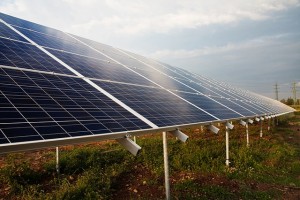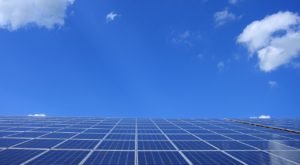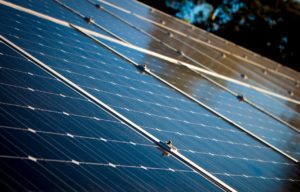
Setting up a solar farm can be financially rewarding. It’s good for the planet, too, especially as we’ve finally realised just how much damage coal and gas are doing to our environment. However, no-one would say it was easy, and solar farm costs can be high, both during the initial installation and to pay for ongoing maintenance.
To help you learn more about generating profit from sunshine, we’ve put together this super-guide to cover everything you need to know to make your solar farm a success. We’ll take a look at solar farm costs, how to find funding to start up your enterprise, running your farm to maximise your returns, and how to protect your investment.
Setting up basics
Solar power facts:
- Solar power is popular with the public – more than 80% of the British public support green energy production like solar, and it’s seen as a positive and sustainable energy source for the 21st century
- Solar farms could provide a return of around 6% a year
- They provide a clean, renewable source of energy that could help prevent future energy shortages
- On May 1st 2018, the UK generated 24.3% (8.7GW) of its power from solar panel arrays (both domestic and commercial), which means it is already close to achieving the EU’s renewable target of consistently sourcing 15% of energy from renewables by 2020
- Despite the reduction in subsidies for solar farms, new projects are still coming onstream, such as the 45-acre site at Clayhill in Bedfordshire, the UK’s first subsidy-free farm. The farm came onstream in 2017 and generates enough power for 2,500 homes.
What is a solar farm?
A solar farm uses photovoltaic cells in an array of solar panels to ‘harvest’ energy from the sun. Unlike domestic solar panels, the scale of a solar farm is much, much larger, and can cover anything from one to 100 acres.
Panels are either laid out in rows on the ground to create a ground-level array, or are put on the roofs of commercial buildings. The panels need to be in a spot that receives maximum sunlight (preferably facing due south or south-west to capture the maximum amount of sunshine throughout the day). The energy captured is stored in banks of batteries or fed directly back into the National Grid.
For commercial enterprises that have panels on their roof this means that they can cover their own energy requirements without using the mains supply. Any surplus energy generated is then put back into the National Grid and is an additional revenue stream for the business.
Harvesting solar energy in this way also improves the green credentials of the business.
 How much energy will it generate?
How much energy will it generate?
To generate 5MW of power requires an array covering approximately 25 acres of land. Based on the average annual energy consumption of a UK household, a solar farm of this size will generate enough power for approximately 1,500 homes a year.
Solar farm cost: financing your farm
Solar farms have found particular favour with arable farmers who are looking to diversify and generate new streams of revenue from the land. However, set-up costs for a solar farm can be substantial.
After the government cut subsidies for solar farms in 2015, the industry did stall. However, as the cost of the technology involved fell and photovoltaic cells became far more efficient at converting sunlight to energy, there has been a renewed interest in subsidy-free farms. While you may see an initial return on your investment in the form of lower energy bills and a new revenue stream, the start-up costs may outweigh the ROI for several years.
There are two options: you can either fund the installation of the panels yourself with a loan, or you can create a cooperative group and allow members of the community to both invest in and benefit from the scheme. This is proving to be one of the more popular options in the post-subsidy landscape, and communities who choose this option are seeing a good return on their investments.
With a community co-operative, each member is invited to purchase shares in the business, the funds going towards setting up and running the farm. A good example of this type of community-based enterprise is the Westmill Solar farm, which has over 1,600 members who have all invested in the project.
Bear in mind that photovoltaic cells have a finite lifespan, and will need replacing after around 30-40 years or so. To ensure you get the best return you will need to calculate ‘consumables’ such as the panels into your solar farm costs.
Planning guidance
The installation of solar panels on non-domestic buildings and land may be considered ‘permitted development’, and as such may not need planning permission. However, because solar farms can have an effect on the surrounding area and in some instances may be proposed in areas of outstanding natural beauty, there are limits to ‘permitted development’. If you’re planning to install a solar farm and especially if you’re doing so in a rural area, it is essential you contact your local planning authority to find out if you’ll need to apply for consent.
If you’re planning a farm in a rural location then you will also need to consult with Natural England to ensure the environment is not negatively impacted by the proposal. This is not the time to try ‘retrospective permission’, as the level of initial investment could be exceptionally high, and any delays or even a rejection of your application could leave you thousands of pounds out of pocket.
Technical considerations during planning stage:
You will need to submit a certain amount of information for your proposal, including:
- Solar resource – estimates on how much energy you are expecting to generate
- Topography – the position of the farm and its potential impact on the surrounding countryside both visually and productively
- Proximity to existing grid infrastructure – how easy is it to supply the energy generated to the National Grid
 Environmental considerations during planning stage:
Environmental considerations during planning stage:
Environmental considerations are exceptionally important and you will need to demonstrate:
- How the farm may affect the soil and soil structure of the site and surrounding area
- Wildlife habitats and designated sites – Is the farm located in a sensitive area (for example, close to sites of Special Scientific Interest or Outstanding Natural Beauty)?
- Effects on specific, protected wildlife species – is the site home to any protected wildlife species, such as great crested newts?
- The potential environmental impact the site may have on the landscape
- Whether or not the building of a solar farm will have an impact on the character of the landscape
- Whether the farm would cause any damage to geological and archaeological features
- Implications of water run-off – will the site cause flooding or possibly contaminate any groundwater or watercourses?
Compared to wind farms, solar farms have less visual impact and create no noise issues. However, it is important to ensure that the farm is well screened to minimise the visual impact. Doing so, as well as working with the community to develop the site as a co-operative, can help to reduce any potential objections or blockages to the planning process.
Feed in Tariffs
The Feed-in Tariffs (FITs) scheme was a government scheme designed to help increase the uptake of a range of small-scale renewable and low-carbon electricity generation technologies. However, in December 2018 the decision was made to close the scheme to new applications after 31st March 2019.
Is starting a solar farm profitable?
Maximise your return on investment by considering the following 4 essential factors:
1. Positioning your solar panels
Maximise the amount of energy you generate by ensuring your array is positioned in full sun for as long as possible throughout the year. That means facing due south or south-west. Panels will generate power even if they aren’t facing those directions, but the amounts will be lower as they’re exposed to sunlight for shorter periods.
To make the most of the sunshine consider installing motors that allow panels to track the movement of the sun through the sky. This will increase the initial investment level, so ensure that the cost will be offset by higher power generation. Alternatively, you can increase output by installing a Fresnel lens or mirror that will concentrate the sun’s rays onto the panel.
Ensure that trees and bushes do not shade the panels and ensure your site is maintained throughout the seasons.

2. Keeping your panels clean
Solar panels make energy from sunlight – and the more sunlight that gets to them, the more they will produce. If they are covered with dirt or leaves, this will reduce their effectiveness and could even damage the cells. Keeping them clean and well maintained ensures they work at maximum capacity.
Google did some research into the benefits of cleaning their solar panels at their office in California and found that clean panels increased output by 36%.
3. The lifespan of your panels
Solar panels are durable and designed to withstand being out in all weather for a long time. Generally speaking, a solar panel will last around 30-40 years, but will have declining efficiency levels after around 25 years. Expect a drop of around 0.5% in efficiency every year. The inverters, which transform the energy produced into the AC power, generally have a shorter lifespan of around 15 years.
Keeping your inverter up to date and working efficiently will help you to make the most of your solar panels.
4. Understand (and check) your output
Regularly check your energy output using a monitoring system. If you notice a substantial drop in energy production you should identify the cause and carry out maintenance or repairs to bring efficiency levels back up.
Support from the Solar Trade Association
Solar Energy UK is a not-for-profit organisation that offers resources and guidance on all aspects of solar energy production for both commercial and domestic installations. All members of the Association follow best-practice guidelines to ensure solar farms are delivering a positive influence on both the energy production of the UK, and the environment. Their main points include:
-
-
- Focusing on building solar farms on non-agricultural land or land which is of lower agricultural quality
- A sensitivity to nationally and locally protected landscapes and nature conservation areas, and ensuring the industry does everything to enhance the ecological value of the land
- Minimising the visual impact of farms and maintaining appropriate screening throughout the lifetime of the project, managed through a Land Management and/or Ecology plan
- Working with the community before submitting planning applications, seeking their support and listening to their input on how the development should take place
- Encouraging diversification by integrating continued agricultural use or incorporating biodiversity measures
- Buying goods and services locally, and employing local traders and operating staff
- Having due consideration for both the environment and local people during construction, and demonstrate ‘solar stewardship’ of the land for the lifetime of the project
- Offering investment opportunities to communities so that they can become shareholders in local solar farm developments
- Using the solar farm as an educational opportunity for local schools, colleges and groups
- Returning the land to its former use at the end of the project, with no detrimental long-term impact on the environment.
-
 Protecting your solar investment
Protecting your solar investment
Once you’ve got your solar farm set up and running you’ll need to think about the potential risks. To offset these you will also need to look at various types of insurance, in the same way that you would with any other business. Your solar farm could make up a substantial part of your income, if not all of it, so make sure that it’s covered by the right insurance.
Key insurance areas to consider include:
Machinery breakdown – electrical and/or mechanical breakdown of any machinery or other equipment could result in costly repairs or even require replacement of the solar panels
Business interruption –there will be times when your farm is not generating power due to machinery failure, storm damage or equipment failure. To ensure you still have an income coming in to cover your costs, business interruption insurance is essential. It can also cover lost revenue associated with the failure or physical damage to property that is not part of the array, such as a utilities substation.
Property damage – extra ‘all-risks’ cover to protect from any loss arising from of fire, hail or storm damage, which is normally excluded from standard policies.
Contract works – protection against any loss arising from property damage caused during the construction of the project. Remember that photovoltaic cells are delicate and can easily be damaged during installation. Contract works protects you against the value of labour and materials of the work in progress in the event that it is damaged by theft, vandalism, fire, storm, etc. Cover starts while solar panels are in transit to the job site, and ends once the job is completed or the owner accepts the work
Computer – Solar farms rely on the use of computers to operate them. This specialist computer equipment has its own value as part of your solar farm costs. Reinstatement of Data cover should also be considered to protect from any loss of valuable data.
Employers’ liability – provides cover against risk of accident from usual workplace risks such as working at height and manual handling
Public liability – provides cover against risk of accident from usual workplace risks such as working at height and manual handling. Remember, if you employ anyone, even on a part-time basis, this is a legal requirement
Directors and officers cover –helps protect company directors and officers if they’re accused of any ‘wrongful acts’
You might only need a few of these insurance options, or you might need them all. Whatever your requirements, at Park Insurance we are specialists in getting our customers the best possible deals on their insurance and bring down your overall solar farms costs.
With over 30 years’ experience and an in-depth understanding of ‘niche’ industries such as solar farms, our professional team has the expertise and knowledge you need to get tailor-made cover for your solar enterprise at the right price. </strong?
Solar farm costs are considerable, but with Park Insurance’s help, we can keep at least one aspect of your start-up costs down to a manageable level.Talk to our expert team on 0117 955 6835 today or fill in the form below for a free, no obligation quote.
